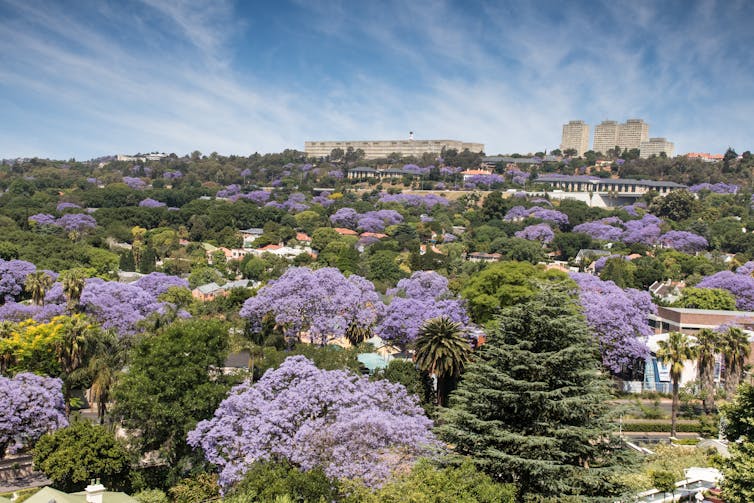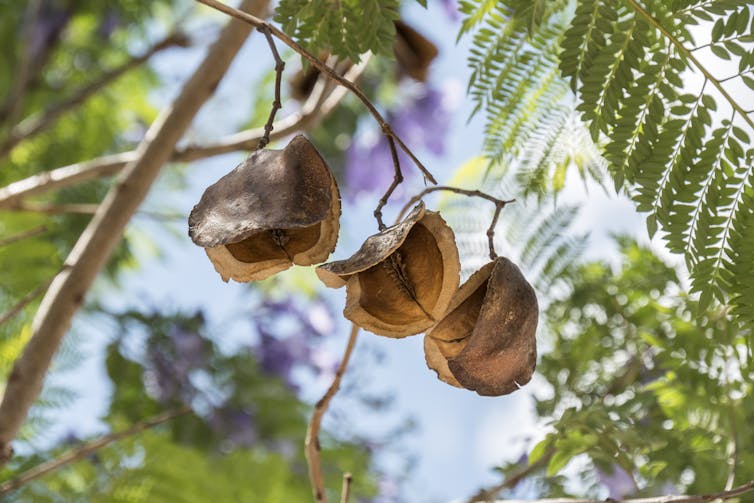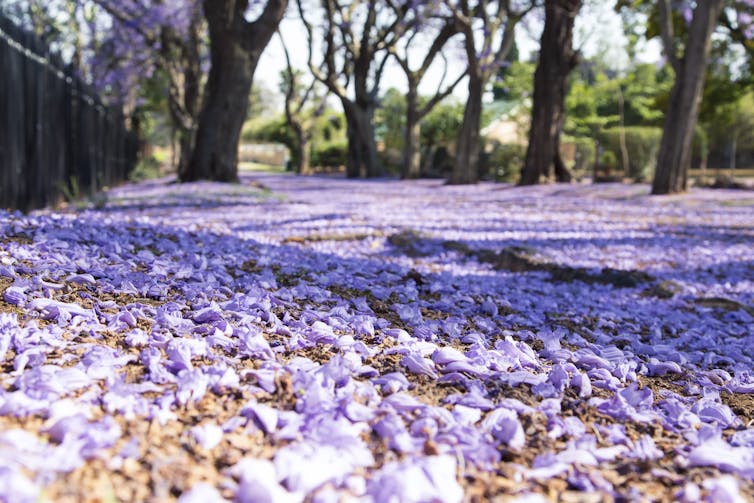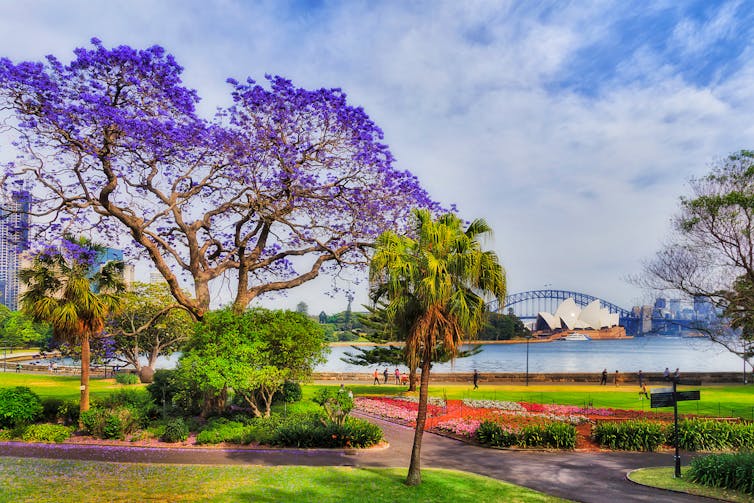
Shutterstock
Every year, as spring arrives, the streets of Australia are transformed into a vibrant purple wonderland with the arrival of the delicate jacaranda flowers. Interestingly, this year, these beautiful flowers might be seen blooming even during the Christmas season.
The color of the jacaranda flowers has always been a subject of debate. Some argue that it is indigo, while others believe it is blue or purple. The truth is that the color varies, ranging from darker to lighter shades depending on factors such as the specific species, soil quality, and the time of the year.
Despite its popularity and widespread love among Australians, it may come as a surprise to many that the jacaranda tree is not actually native to Australia. Native to South America, particularly Argentina, the most common variety found in Australia, known as Jacaranda mimosifolia, is believed to have originated from this region.
Because of this and other reasons, there are some people who don’t share the same admiration for the jacaranda tree.

Jacarandas, originally from South America, have gained worldwide admiration for their breathtaking flowers. These trees have become the center of festivals in various towns across Australia, such as Grafton, Applecross, Goodna, Camden, Woodville, and Ipswich. Even at the University of Queensland, students refer to the blooming jacarandas as “purple panic,” signifying the arrival of end-of-year exams.
Besides Australia, jacarandas have flourished in regions like California, Texas, Florida, southern Italy, Malta, Portugal, Spain, and India. I personally have had the pleasure of witnessing their beauty in Pretoria, the capital city of South Africa, famous for its jacaranda trees. Additionally, Gaborone, the captivating capital of Botswana, also boasts an impressive population of these trees.
The widespread presence of Jacaranda mimosifolia around the globe is a testament to its adaptability. Although susceptible to frost when young, these trees are hardy and can thrive in various soil and climate conditions. Moreover, in warm climates, their attractive flowers are accompanied by alluring dappled shade, making them even more appealing.

In Pretoria and Johannesburg, the growth of jacarandas is widespread. However, despite their abundance, these trees have been deemed invasive weeds. Interestingly, in their natural habitat in South America, jacarandas are actually threatened or vulnerable due to the conversion of their land for agricultural purposes.
Apart from their visually stunning flowers, jacaranda trees have other qualities that attract various birds and insects such as the African honey bee and local honey-eaters. Belonging to the Bignoniaceae family, which predominantly thrives in tropical regions, jacaranda is just one example of the woody species within this family. However, there are many other “lianes” or climbers, reminiscent of Tarzan swinging through the jungle.
Jacaranda trees possess both soft and brittle wood, and as they age, they develop large, pod-like fruits that turn brown as they dry out. While these pods may initially be disconcerting due to their rattling in the wind, they actually create a soothing sound reminiscent of a natural wind chime. Furthermore, as Christmas approaches, some individuals collect these pods, decorate them, and utilize them as ornaments.

Once the stunning purple blossoms of the jacaranda tree have withered away and its pods have dried, you can unleash your creativity by transforming them into unique and eco-friendly Christmas ornaments. Simply adorn these pods with your preferred decorative elements, and you’ll have a charming addition to your holiday decor.
While the jacaranda tree offers some remarkable qualities, it does come with its fair share of drawbacks. The branches and twigs of this tree are prone to breakage, emitting a loud crack when they snap. However, the larger pieces of wood can be repurposed for woodworking projects such as bowls and handles. On the downside, the wood’s brittleness makes the tree susceptible to wind damage, although this mostly affects the smaller branches and twigs.
Interestingly, jacaranda has gained a notorious reputation as an invasive weed in regions like South Africa and parts of Australia. The woody fruits of the tree contain fine seeds that readily germinate, adding to its invasive nature. Consequently, eradicating jacaranda in Africa has proven to be an arduous task, necessitating official permission for planting.
Furthermore, the roots of the jacaranda tree can extend quite extensively, potentially causing damage to paths and fences, particularly in certain soil types. This robust root system allows the jacaranda tree to outcompete native species like grasses and wattles, creating an environment where few other plants can thrive. In fact, it can even give rise to dense seedling thickets in such circumstances.

In the event of rain, caution must be exercised when walking on the ground covered in fallen jacaranda flowers, as they can turn slippery and pose a danger.
Furthermore, the shedding of the jacaranda tree’s delicate and feather-like leaves can lead them to infiltrate every small space, including roofs and ceilings. While the tree itself is resistant to fire, the gathered leaves can form thick, dry mats that pose a fire hazard. Additionally, they have the potential to clog gutters and drains, causing considerable damage to homes during heavy rainfall.
Additionally, when jacaranda flowers shed, they become almost translucent and fragile. When combined with rain, these flowers can create a slippery surface.
Looking towards the future, the prospects for the jacaranda mimosifolia in Australian cities are promising. This species is well-suited to thrive in the warmer and drier conditions expected under climate change. However, in rural and regional areas of Australia, precautions must be taken to prevent the jacaranda from becoming invasive and causing potential issues.

It is highly likely that jacarandas will continue to be a prominent feature in urban areas across Australia for many years to come. The nursery industry may find a solution to the problem of the jacaranda’s ability to produce fruit and seeds by developing fruitless or seedless varieties, similar to what they have done with the white cedar tree. This would help prevent the jacaranda from spreading uncontrollably and allow it to grow only in designated areas. Nevertheless, it is almost certain that Australians will continue to enjoy the breathtaking sight of the jacarandas in full bloom during the hot summer months for many more decades. To add to the mix, the white cedar tree is a unique and interesting Australian tree that sheds its leaves during winter.
